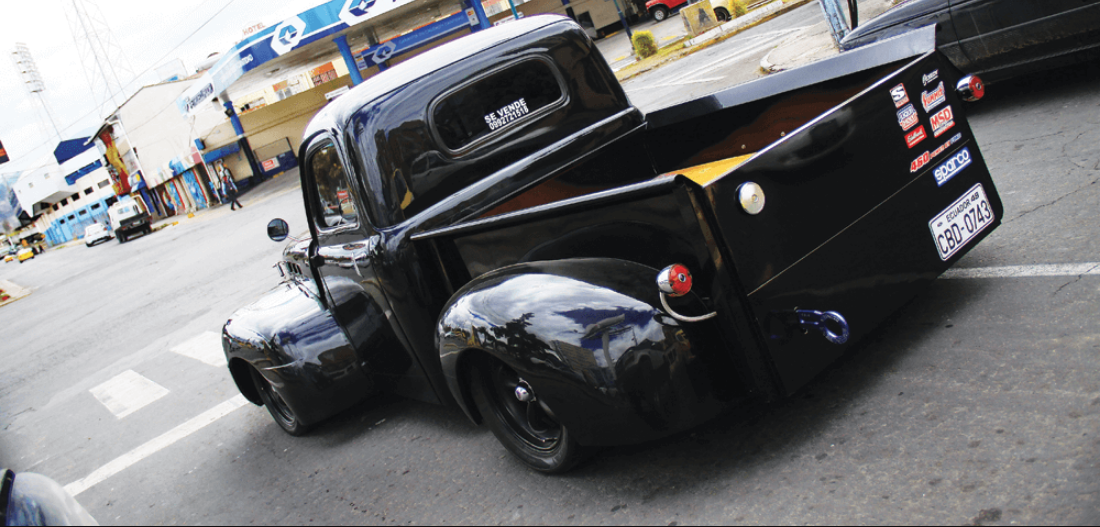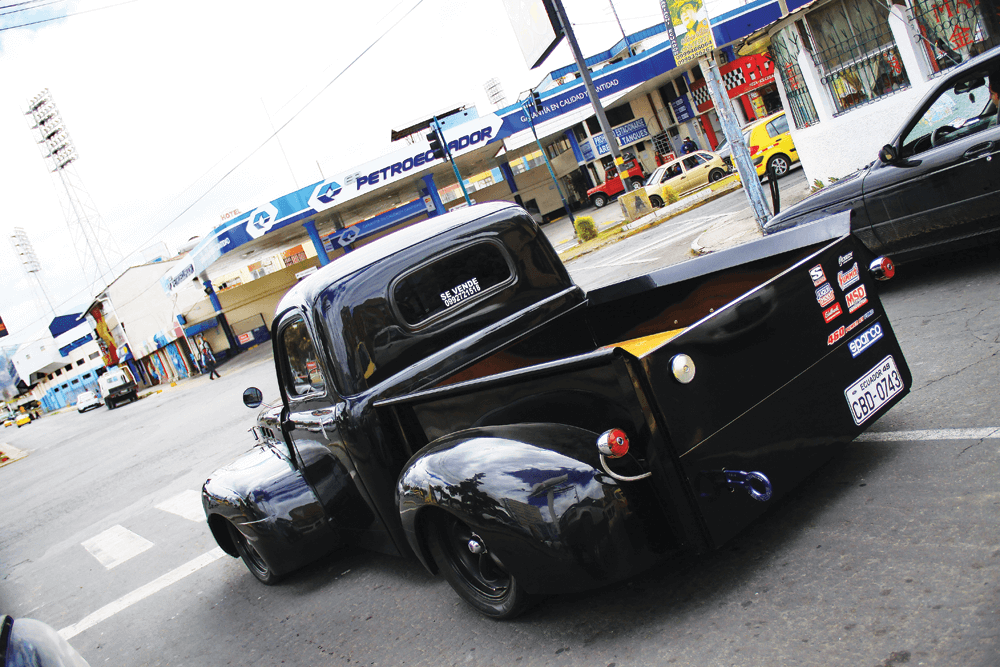 ROBB
.
September 28, 2023
.
F100 Builders
ROBB
.
September 28, 2023
.
F100 Builders

When you look at this stunning South American Ford in all of its glory, it’s hard to imagine that the build started off as nothing but a long-abandoned cab that was being used as a pig sty on the side of a volcano.
In the small town of Riobamba, a couple of hours south of the Ecuadorian capital Quito, Pepe and his son Josh had been looking for a classic pickup to turn into a project vehicle for a while. They hadn’t come across anything that could be used as a suitable starting point, until one day a familiar shape caught their attention in the field off a local back road. On closer inspection, their first thought was confirmed: It really was an original cab from a ‘48 Ford. After a princely sum of $1,200 was handed over, they went back with spades and pickaxes to dig it out of the ground. The next job was washing the decade’s worth of pig mess out if it, and so began a project that eventually cumulated into this stunning, traffic-stopping custom pickup.
Josh, still only in his early 20s, had always been into the classic/retro look rather than the souped-up Japanese hot hatches of his local car enthusiast peers. From the outset, Josh had a few ideas about which way he wanted this project to go. Two things he was sure of were that this truck wasn’t going to be just for show and it was going to be extremely unique. Surfing the internet and diving into the truck scene in America made it obvious that many ‘48s had gone the route of a little bit rat rod, a little bit hot rod. But Josh had the idea of competing against other builders with his truck on the track. ‘48 Ford rally car? Not so many of those around these parts.
Ecuador is a strange little country. Touching the Pacific, Andes and Amazon, it’s an incredibly diverse place, but a draconian rule that has stood for generations states that only brand new cars can be imported, and prohibitively expensive importation taxes are ultimately added. Flat out, it means that this is the most expensive country in the world to buy a car. The rule is simple: If it’s not new with papers to prove it, it’s not coming in. Classic car ownership, and especially building something heavily modified, is therefore a serious labor of love and logistics. Keeping to a sensible budget for the build was managed using locally sourced parts or custom fabricated pieces.

To begin, a couple of donor vehicles were purchased to aid in the restomod. A Bronco and an F350, both from the early 90s, had beneficial gear Josh was able to recycle. The Bronco’s chassis was more suited to their needs, so minus some superfluous cross members and a few inches lopped off the front and rear, this is what they mounted everything to. The rear axle casing also came from the Bronco, but everything from the front was jettisoned as 4×4 wasn’t needed.
“The exhaust, too. A bit like some prehistoric cave paintings, it’s a work of art that only the most intrepid get to see. I had to hunker down in an oily mechanic’s pit to see how well they’d worked the tubing from the bunches at the block down to the tail.”
The 460c.i. big block was pulled out of the 1992 F350, and although they only wanted the engine, they had to buy the rest of the truck with it. All of the internals are stock, with the exception of sodium filled valves to cope with extra heat from the levels of combustion that Ford never intended this block to have.
A fuel injection system is designed specifically to use as little fuel as possible, but for a performance car the idea is to get as much fuel as possible into the cylinders. To this end, a gorgeous 750 CFM Eisenbach carburetor with electric choke was fitted and sits proudly on top of the block, muscle car style. With the fuel inlet channels bored out, the fuel economy was reduced dramatically but, of course, the power increased in direct inverse proportion. From a not particularly lethargic 289 bhp it now puts out a much more sporty 350 bhp, although that figure is just an educated guesstimation as no one in Riobamba has a dyno to be able to test it. For the same reason they have no idea what the torque rating is. The top speed is 260 km/h, although how they found that out is not really printable without getting them into trouble.
Power goes through a ceramic-plated Exedy Racing performance clutch into an interestingly Frankenstein gearbox with a hodge-podge selection of parts from different Ford vehicles. The cost of buying and importing a competition ‘box from America was out of the question, especially as whatever they got would have had to have been brand new, so Josh played around with taking different gear cogs out of different Ford F-series gearboxes until he found the right settings. First to third gears are now much shorter for better acceleration, and he’s also very happy with how smooth and fast the changes are. Buying four gearboxes to get the needed parts still wasn’t cheap though!
Inside the Bronco rear axle casing are standard F150 shafts, but something else it was impossible to find in Ecuador was a suitable crown and pinion for the rear diff. It needed to be the right ratio and also massively strong, so a small package was freighted over from Ford Racing. By the time it got through the border controls it cost $2,300!
Another difficult engineering issue to get right was finding a balance between the steering having a usable lock without the wheels fouling against the fenders. There was no other build to copy, not on the internet and certainly not locally, so it was two weeks of trial and error resetting the suspension mounts until it worked. Pepe smiles and says, “Mucho trabajo!” It was the same for the brackets for the new 11-inch calipers on the rear axle that replaced the old Bronco drums. A set of 2012 F150 calipers now slow the rear down while a hefty set of double calipers from an F250 are on the front with Ford Performance ceramic coated pistons. With wide Kumho tires, 305/50-17s on the back and 245/45-17s on the front, in contact with the road and brakes designed for something twice its weight, it stops very well. The wheels, matte black and pretty well hidden under the wings, are at set of 17-inch Rev Classic 5-spokes.
The front suspension arms are not designed for cruising around town. When it’s pushed in competition this beast gets airborne (it even pulls wheelies!), so the arms have more in common with Trophy Trucks from the Baja 1000 than anything made for the street. Each arm is 1.3 meters long… but the truck is not 2.6 meters wide. To get enough travel so that they weren’t bottoming out on every jump, they designed the arms to pivot from opposite sides of the chassis. That’s some serious engineering for a guy and his son in grandma’s garage!
The exhaust, too. A bit like some prehistoric cave paintings, it’s a work of art that only the most intrepid get to see. I had to hunker down in an oily mechanic’s pit to see how well they’d worked the tubing from the bunches at the block down to the tail. Riobambans live in the shadow of Cotopaxi, one of the most active volcanoes in the world and the low rumbling growl is pretty much the same noise the locals have been preparing for when it next blows its top. This is quite possibly why many people cowered for cover as we powered around the grid like streets.
“Built with what parts were available and expensive purchases kept to a minimum, this truck is much more than the sum of its parts. In Ecuador, it’s utterly unique but it would also hold its own in any American truck show.”
To save both money and the time it takes to get things through customs, they wanted the car to have as many locally sourced parts as possible, but searching around Ecuador for wings and doors for a 70-year-old car proved fruitless, and so the replica body panels came from Dennis Carpenter in California. To save as much weight as possible, all the supports were taken out of the bonnet and wings… (it now opens with the help of a baseball bat, apparently a useful accessory to carry with you in some parts of the country) and because the car was both lowered and sported much wider wheels they were also going to have to engineer a way for the wheels to steer under the front arches. It was for this reason that they widened all the fenders by 4 inches, but it is this practical modification that’s made this car look so good. Working with such gracefully curved metal is an artisan’s job though and one Josh took to a local sheet metal worker to make sure it was done properly. I had a careful look. The work is seamless.
Understandably, there isn’t a company that makes race-spec roll cages for a ‘48 cab, so a lot of measurements were taken and a mock-up made with much thinner tubing to test the angles and dimensions. There’s no FIA health and safety rules for racing in Ecuador, so the joins didn’t need to be seam welded and certified. Pepe’s solution was to bend the pipes with a hydraulic bender and fasten them together with double-studded brackets. Not FIA, but safe enough. Hopefully.
The interior looks like a catalogue photo for Sparco. With the steering wheel and Evo seats, it’s part spartan race car and with just a single gauge, that of a rev counter redlined at 8,000 rpm, and the lovely gleaming chrome work on the dash, also from Dennis Carpenter, it’s also beautifully classic as well. There is of course no stereo.
Despite being built from the ground up for racing, the first thing the car won was a show… but that was just an indication of things to come. Josh entered a hillclimb event near the capital Quito and in his first ever race won the pickup class! I asked where he learned to drive like that, but he insists that that was his first time ever driving at competitive speeds.
“I guess it’s in my DNA,” he shrugs.
A couple of months later in his first circuit race he got 2nd..He started near the back and just couldn’t quite catch the 2015 Corvette in time before the checkered flag fell.
Built with what parts were available and expensive purchases kept to a minimum, this truck is much more than the sum of its parts. In Ecuador, it’s utterly unique but it would also hold its own in any American truck show.
Share Link